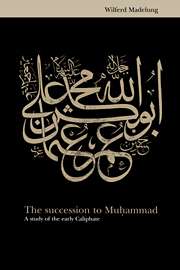The Succession to Muhammad
The Succession to Muhammad is a book by Wilferd Madelung published by the Cambridge University Press in 1997.[1] Madelung investigates the events after the death of Muhammad, where there was a battle to see who would control the Muslim community. This struggle resulted in the difference between Sunnite and Shi'ite Islam over authority (spiritual and temporal).
 | |
| Author | Wilferd Madelung |
|---|---|
| Country | United States |
| Language | English |
| Subject | Succession to Muhammad |
| Genre | Non-fiction |
| Published | 1997, Cambridge University Press |
| Media type | Print, e-book |
| Pages | 432 pages |
| ISBN | 0521646960 |
Reception
The Journal of the American Oriental Society applauded Madelung's mastery of the subject, but was critical of his reliance on ancient sources and neglect of modern scholarship, stating that the author "falls outside the emerging consensus in the field which maintains a moderately skeptical attitude toward the Arabic materials". It further comments although Madelung did take an "optimistic view of the sources" and "Crone's and Hinds' ideas about the nature of caliphal authority are dismissed in one sentence", it still "offers a chance to see the Shi'ite case imaginatively made by a master scholar in complete control of the sources."[2] Iranian Studies also praised the work.[3] Hugh Kennedy writing in Journal of the Royal Asiatic Society praised the range and depth of his knowledge and welcomed what he saw as a pro-Alid reading of the early Islamic history against a backdrop of earlier pro-Sunni scholarship, but objected that Madelung may have gone too far, stating that "When Mu'awiya finally entered Kufa, Madelung tersely observes, 'The brute was celebrating victory' ... it is not clear that such openly partisan comment is appropriate in a work of historical research."[4] Ingrid Mattson writing for Journal of Religion observes "It is truly puzzling then that in his new book, Madelung presents what seems to be an almost partisan argument about the position of Ali".[5]
References
- Hughes, Aaron W. (2013). Muslim Identities: An Introduction to Islam. Columbia University Press. pp. 116–117. ISBN 9780231531924. Retrieved 30 November 2014.
- Lewinstein, Keith (April–June 2001). "The Succession to Muhammad: A Study of the Early Caliphate (review)". The Journal of the American Oriental Society. 121 (2): 326. doi:10.2307/606600. Retrieved 30 November 2014.
- Newman, Andrew J. (Summer 1999). "The Succession to Muhammad (review)". Iranian Studies. 32 (3): 403–404. doi:10.1080/00210869908701963. JSTOR 4311271.
- Kennedy, Hugh (1998). "The Succession to Muhammad: A Study of the Early Caliphate by Wilferd Madelung (review)". Journal of the Royal Asiatic Society. 8 (1): 88–89. doi:10.1017/s1356186300016473. JSTOR 25183470.
- Mattson, Ingrid (April 1998). "MADELUNG, WILFERD. The Succession to Muhammad: A Study of the Early Caliphate (review)". The Journal of Religion. 78 (2): 321–322. doi:10.1086/490222.